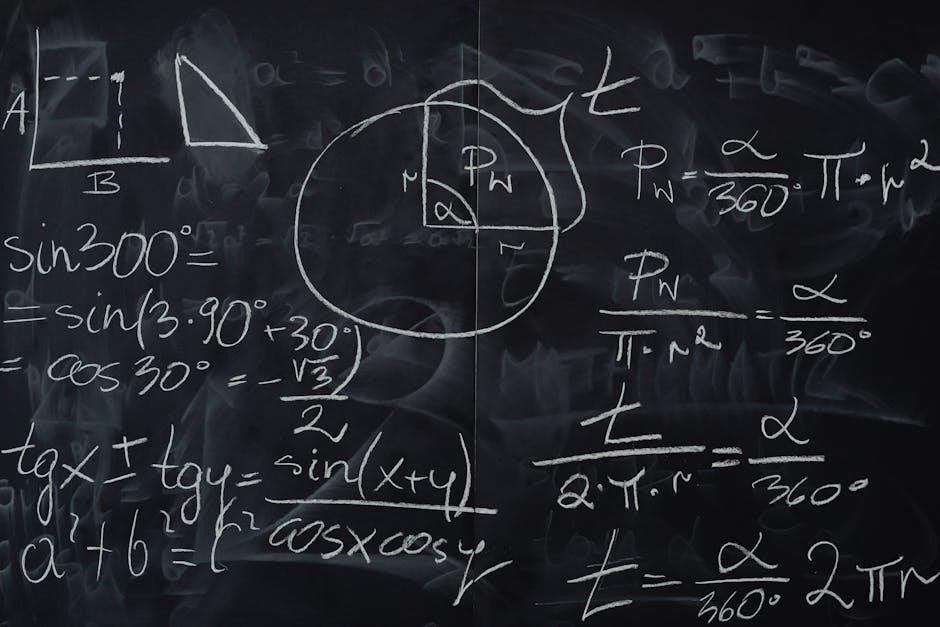unit 7 test study guide right triangles and trigonometry

The unit 7 test study guide covers right triangles and trigonometry concepts, including guided notes and homework assignments, to help students prepare for the test, using online resources and study guides, such as CliffsNotes, effectively now.
Overview of Right Triangles and Trigonometry
The study of right triangles and trigonometry is a fundamental concept in geometry, and it is essential to have a comprehensive understanding of these topics to excel in the unit 7 test.
The online resources and study guides, such as CliffsNotes, provide a detailed overview of right triangles and trigonometry, including the properties of right triangles, trigonometric functions, and the relationships between the sides and angles of a right triangle.
Using these resources, students can gain a deeper understanding of the subject matter and develop problem-solving skills to tackle complex problems.
The overview of right triangles and trigonometry also covers the different types of triangles, including acute, right, and obtuse triangles, and the various trigonometric identities and equations that can be used to solve problems.
By mastering these concepts, students can build a strong foundation in geometry and prepare themselves for the unit 7 test, and the online resources and study guides can serve as a valuable tool in achieving this goal, and provide additional support and guidance throughout the learning process, and help students to stay on track and focused.

Pythagorean Theorem and Applications
The Pythagorean Theorem is used to find lengths of sides of right triangles, with applications in geometry and trigonometry, using online resources to learn and apply the theorem effectively now always.
Classifying Triangles and Converse of Pythagorean Theorem
The converse of the Pythagorean Theorem is used to classify triangles as acute, right, or obtuse, by using the lengths of the sides to determine the type of triangle. This concept is crucial in geometry and trigonometry, as it helps to identify the properties of triangles. The Pythagorean Theorem states that in a right-angled triangle, the square of the length of the hypotenuse is equal to the sum of the squares of the lengths of the other two sides. The converse of this theorem states that if the square of the length of the longest side is equal to the sum of the squares of the lengths of the other two sides, then the triangle is a right triangle. This concept is used to classify triangles and solve problems in geometry and trigonometry. Online resources, such as study guides and tutorials, can help students to understand and apply this concept effectively now and always in their studies. By using these resources, students can gain a deeper understanding of the converse of the Pythagorean Theorem and its applications in geometry and trigonometry.

Special Right Triangles
Special right triangles have unique properties, including 30-60-90 and 45-45-90 triangles, used to solve problems, with online resources and study guides available to help students understand these concepts effectively now always.
Solving for Unknown Values and Simplified Radicals
To solve for unknown values, students can use the Pythagorean Theorem and other trigonometric concepts, such as sine, cosine, and tangent, to find missing sides and angles in right triangles. Online resources, including study guides and video tutorials, can provide step-by-step instructions and examples to help students understand these concepts. Additionally, students can use simplified radicals to express their answers in a more concise and elegant form. By practicing with sample problems and exercises, students can develop their skills and confidence in solving for unknown values and simplified radicals. The key is to carefully read the problem, identify the given information, and apply the relevant concepts and formulas to find the solution. With patience and persistence, students can master these skills and achieve success in their unit 7 test study guide on right triangles and trigonometry. Effective use of online resources and study guides can also help students to review and prepare for the test.

Trigonometry and Triangle Properties
Trigonometry concepts, including sine, cosine, and tangent, are used to analyze triangle properties, such as angles and sides, in the unit 7 test study guide on right triangles and trigonometry effectively now always.
Tangent and Altitude of Isosceles Triangles
The concept of tangent and altitude of isosceles triangles is crucial in understanding right triangles and trigonometry. According to online resources, such as CliffsNotes, the tangent of an angle in a right triangle is defined as the ratio of the length of the side opposite the angle to the length of the side adjacent to the angle. The altitude of an isosceles triangle is a line segment drawn from the vertex of the triangle to the base, forming a right angle. In the context of the unit 7 test study guide, students are expected to find the tangent of an angle and the altitude of an isosceles triangle, using trigonometric ratios and properties of right triangles. This requires a deep understanding of trigonometric concepts, including sine, cosine, and tangent, as well as the ability to apply these concepts to solve problems involving right triangles and trigonometry. By mastering these concepts, students can effectively prepare for the unit 7 test and achieve academic success. The study guide provides ample practice problems and examples to help students reinforce their understanding of tangent and altitude of isosceles triangles.

Review and Preparation for the Test
To prepare for the unit 7 test, students should review the key concepts and formulas related to right triangles and trigonometry, using online resources such as study guides and practice problems. The review process should involve re-reading notes, re-working practice problems, and taking practice quizzes to assess understanding. According to CliffsNotes, a popular study guide, reviewing and practicing consistently can help students score high on exams. Additionally, students can use flashcards to memorize key terms and formulas, and create concept maps to visualize relationships between concepts. By reviewing and practicing regularly, students can build confidence and develop a deeper understanding of the material, leading to better test results. The unit 7 test study guide provides a comprehensive review of the material, including sample questions and answers, to help students prepare for the test. Effective time management and a well-structured study plan are also essential for successful test preparation. Students should allocate sufficient time to review each topic and practice problems.